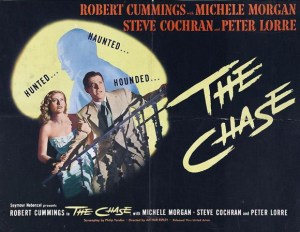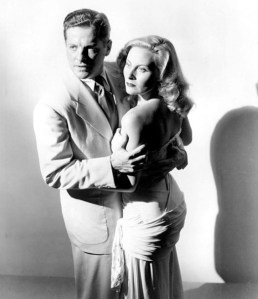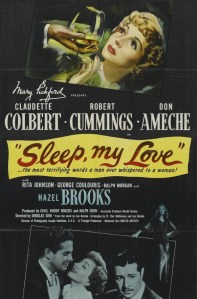 Arthur D. Ripley’s The Chase is based on Cornell Woolrich’s 1944 novel The Black Path of Fear, which was adapted as a screenplay by Philip Yordan.
Arthur D. Ripley’s The Chase is based on Cornell Woolrich’s 1944 novel The Black Path of Fear, which was adapted as a screenplay by Philip Yordan.
Chuck Scott (Robert Cummings), a sailor who was decorated during World War II, is now bedraggled and broke in Miami. While staring longingly through the window of a lunch counter at a griddle full of bacon and flapjacks, he finds a lost wallet full of $20 bills. He decides to return it to its owner, Edward Roman, whose I.D. says that he lives on Hermosa Drive, but not before he “borrows” a buck and a half to buy himself breakfast.
Eddie Roman (Steve Cochran) turns out to be a smooth-talking criminal who lives in a palatial home with his creepy right-hand man Gino (Peter Lorre) and his beautiful wife Lorna (French actress Michèle Morgan), whom he keeps a virtual prisoner. Roman is sinister right from the get-go, slapping a woman (Shirley O’Hara) who pokes him while manicuring his fingernails before he talks to Scott.
Gino and his boss seem amused by Scott’s honesty. (He even owns up to the 12 bits he liberated.) Roman asks Scott why he brought the wallet back. “Now that I’m here I wonder myself,” Scott says. “I guess I’m just a sucker.”
Roman gives “Scotty” — as he calls him — a job as a driver. Scott doesn’t like or trust either Roman or Gino, but he can’t say no to paying work. Things get weird right away. Roman has a contraption in the back seat that allows him to control the accelerator, speeding the car up to more than 100 m.p.h. to see how Scott handles himself. (My wife probably wishes all cars I drove came equipped with this feature.)
One night, Roman entertains a prominent ship owner named Emmerrich Johnson (Lloyd Corrigan), an overdressed fat man who spends most of his time laughing nervously … he can never quite tell if Roman’s joking or not. Unfortunately for Johnson, he doesn’t see the depths of Roman’s villainy and sadism. He’s never joking.
After Johnson refuses to commit to sell Roman the two ships he wants to buy, Gino takes Johnson on a tour of Roman’s wine cellar. While Johnson is excitedly fussing over a bottle of 1815 Napoleon brandy, Gino slips away and locks Johnson in the wine cellar with Roman’s vicious dog. When Johnson is attacked he drops the bottle of brandy on the floor and it runs out along the floor in a convincing approximation of blood. It’s an old cinematic trick, but a good one.
 Meanwhile, Scott and Mrs. Roman are busy falling for each other. After one of their many trips to the beach, where she looks out over the water longingly as he stands behind her, waiting with the car, Lorna offers him $1,000 to take her to Havana. She thinks she can trust him, and she can’t make it on her own. He mulls it over for a little while but quickly gives in, booking passage for two on the S.S. Cuba.
Meanwhile, Scott and Mrs. Roman are busy falling for each other. After one of their many trips to the beach, where she looks out over the water longingly as he stands behind her, waiting with the car, Lorna offers him $1,000 to take her to Havana. She thinks she can trust him, and she can’t make it on her own. He mulls it over for a little while but quickly gives in, booking passage for two on the S.S. Cuba.
They make it to Havana, but their plan to continue on to South America hits a snag, and Scott finds himself on the run, accused of murder.
Things get really weird an hour into the picture, when Scott wakes up in a room with a bottle of pills on the night table and no memory of what happened to him over the course of the past few days.
I haven’t read The Black Path of Fear, but I have read other novels by Woolrich, and blackouts, amnesia, and lost periods of time were recurring themes in his work. Like a lot of Woolrich’s booze-soaked prose, The Chase starts out as a fairly standard thriller, but by the end it’s hard to tell what’s real and what isn’t. In a better film, like Detour (1945), this could be counted as a real achievement. With The Chase, however, the confusion between dreams and reality seems more the result of slapdash filmmaking than anything else.
Cummings has a pleasant way about him, and is believable as an earnest, soft-spoken Everyman. Morgan is beautiful, but the script doesn’t give her a lot to do. Cochran and Lorre are the real gems in this film. Every scene in which they appear is full of menace. Each man has a calm exterior, but there’s always violence roiling below the surface.
If you’re looking for tight plotting or a clever climax, you won’t find it here, but The Chase has just enough oddball charm to recommend it to noir enthusiasts.
 Sleep, My Love is a slick, classy thriller from the slickest, classiest director of all time, Douglas Sirk.
Sleep, My Love is a slick, classy thriller from the slickest, classiest director of all time, Douglas Sirk.
